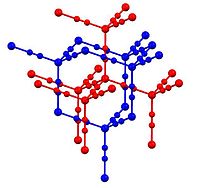
Photo from wikipedia
Stimuli-responsive semi-interpenetrating polymer network (semi-IPN) hydrogels form an important class of polymers for their tunable properties via molecular design. They are widely investigated for a diverse range of applications including… Click to show full abstract
Stimuli-responsive semi-interpenetrating polymer network (semi-IPN) hydrogels form an important class of polymers for their tunable properties via molecular design. They are widely investigated for a diverse range of applications including drug delivery, sensors, actuators, and osmotic agents. However, in-depth studies on some of the critical design principles affecting diffusion/leaching of linear polymer from semi-IPN hydrogels are lacking. Herein, for the first time, by preparing a series of model semi-IPN hydrogels based on thermally responsive poly (N-isopropyl acrylamide) (PNIPAM) network and linear poly(sodium acrylate) (PSA), a systematic and quantitative study concerning linear polymer chain retention and swelling/deswelling kinetics is reported. The study shows that PSA retention is significantly affected not only by PSA molecular weight and concentration, but also by polymerization temperature, which could be linked to homogeneity and internal morphology of the hydrogel. Surprisingly, there is no obvious influence of crosslinking density of PNIPAM network toward PSA retention, while faster swelling and deswelling at higher crosslinking density are observed in terms of swelling rate constant and deswelling activation energy. These findings offer new insights on the factors affecting structural and physicochemical properties of such semi-IPN hydrogels, which should in turn serve as a general guideline for materials design.
Journal Title: Macromolecular rapid communications
Year Published: 2020
Link to full text (if available)
Share on Social Media: Sign Up to like & get
recommendations!